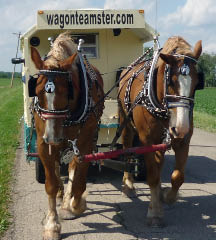|
11/21/08 - While waiting out a winter storm that left a few inches of snow on the road, I decided to write a short pictorial essay of a modern dairy operation.
The horses and I are comfortable on a nice piece of ground and enjoying the day.
The Sterling Heights Dairy is owned by the Sall family. James Sall and his two sons manage and work the operation. Together, they milk about 430 cows, raise their own calves and grow most of their own feed. Itís a fairly modern farm with each cow producing on average over 70 pounds of milk a day.
The cows are milked in a 24 cow parlor. Working with the animals elevated, such that the udders are at arm height makes it easy to clean the udder and teats and attach the milking machines.
This picture shows a row of contented cows on one side of the parlor. Theyíre milked three times a day. This allows for increased production and reduces the occurrences of mastitis.
Pneumatically operated gates let cows into and out of the parlor.
This picture shows the inside end of the milk bulk tank. If a cow happens to be on antibiotics, the milk is not sent to the bulk tank, instead it is drawn off in separate containers and used to feed the heifer calves.
When not eating, the cows get to lay on nice clean sawdust bedding. A comfortable cow stays healthier and produces more milk.
It takes a lot of feed to produce a lot of milk. This picture shows James Sall loading the feed wagon with grain, supplements and soy bean meal.
The next stop for the feed wagon is for dry hay, haylage and corn silage. In addition to the dry hay, the Sallís put up 6,000 tons of corn silage and 3,000 tons of haylage each year. These are stored in large concrete bunkers. The silage is covered to keep out the weather and the air.
This picture shows Mark Sall feeding the young heifer calves in the calf barn. The bedding and the feed buckets are kept very clean to keep the calves healthy. These are the future generation of milk producing cows.
It takes about a week for a calf to learn to drink out of a bucket. This picture shows me lending a helping hand and giving a calf a bottle. A healthy herd like the one here at Sterling Heights doesnít have a lot of cows on antibiotics, so they have to buy a lot of milk replacer to augment the small amount of milk drawn off at the parlor.
This picture shows Mark Sall feeding a young calf. You wonít find any scours or runny noses in his calf barn!
Operating a dairy is a lot of work. The operation runs 7 days a week, 24 hours a day. The current price of bulk milk is pretty good, but when itís down, it makes for some pretty lean years. Costs are high and an awful lot of dairies have gone under in recent years.
|
